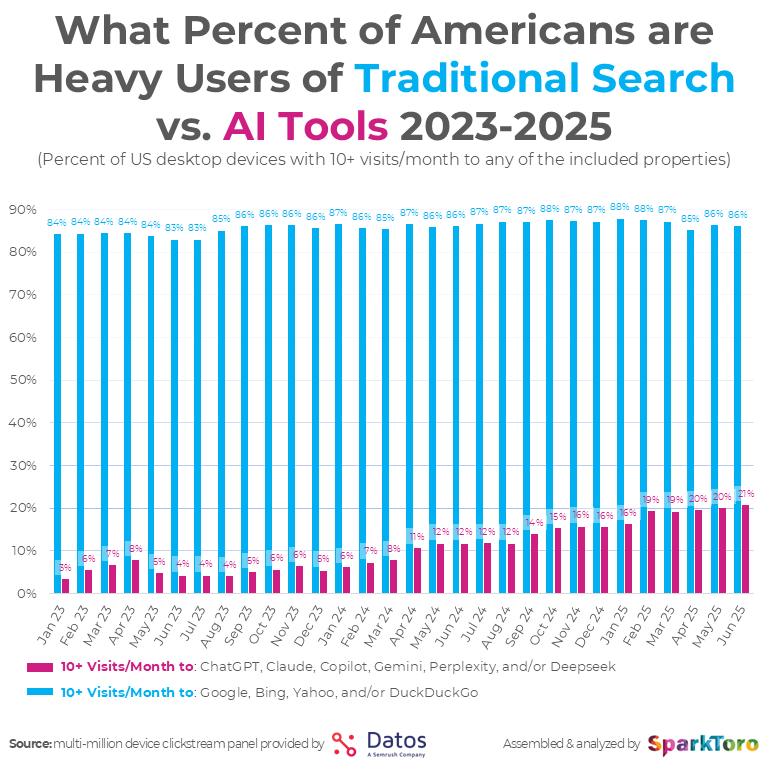Last week, we exhibited at the Technology For Marketing (TFM) Expo at London’s Excel. We were there to promote contentmarketing.ai, our custom-built platform that helps marketers create quality content using AI.
Unsurprisingly, AI was the hot topic at our stand and across the 80 or so talks, presentations and panel discussions that took place over the two-day event.
Marketers are facing both internal and external pressure to capture the benefits of AI, but most are happy to admit they’re still figuring it out.
When it comes to creating content, the two big concerns I heard from marketers stopping by the contentmarketing.ai stand were:
- Is AI content lower quality? Will it provide a short-term boost in terms of more content published with less time, effort and cost, but then fail to resonate with their audience and damage their brand?
- Does Google rank AI content? Is Google trying to detect content created using AI? Does it perform as well as human content in organic search results?
I’ve been working in this space for more than 20 years, so AI is not the first disruptive trend I’ve seen. But I do think it’s the biggest. Here is my take:
Subscribe to the ai marketer
Weekly updates on all things ai in marketing.
AI Content Doesn’t Have to Be a Race to the Bottom
I’ve seen this on LinkedIn and in some industry surveys. And it was there again on the stand at the TFM Expo. Marketers don’t just want to save money, time and effort — they want AI to help them create better content.
I personally hate this “AI slop” term that I keep seeing — mostly from people trying to sell their AI detectors. The idea that content written with AI is by definition lower quality than human content doesn’t stand up to the most basic scrutiny.
Aside from the past 12 months or so, every blog on the internet was written by a human. And almost all of them were uninspiring rehashes that nobody ever read. Drop any blog subfolder into SEMRush and you’ll see that 90% of the posts get zero traffic.
AI is our chance to raise the bar. We can use AI to bring in better, more authoritative sources. We can ensure blogs and other content are based on verifiable facts and data. And AI can help marketers get more expertise, insights and unique perspectives from their product managers and senior execs into everything they publish.
That’s not to say AI content can’t also be more efficient.
A recent Ahrefs survey found AI content was 4.7 times cheaper than human content. But the same survey also showed marketers who use AI are not reducing their spend. In fact, more than half of respondents were gearing up to spend more.
That’s good news for agencies (like ours) that are worried about AI causing smaller deals that no longer cover overheads.
And hopefully, it’s good news for users, too, if brands use that investment to make content more engaging, unique and useful.
Marketers Can Still Learn Lessons From the 2011 Panda Updates
The prospect of using AI to create better content reminds me of Google’s Panda Updates back in 2011.
Ancient history, yes. But also relevant here.
Panda was Google’s attempt to tackle the “human slop” that had flooded its search results during the Web 2.0 revolution. Content creation had become a volume business: create as many articles, covering as many keyword variations as possible. Quality and originality really didn’t matter.
Content farms — often set up in lower-cost markets — churned out mountains of content that no human would ever see.
Google feared users would start looking elsewhere for their information if it couldn’t convince marketers to produce better, more useful content.
What Google didn’t do was try to figure out if content had been offshored to India. It focused on the output.
Panda targeted thin content (low word count, mostly boilerplate) and duplicate content (copy is the same or very similar to other pages). The message to marketers was clear: Produce your content wherever, however you want. Just make it more useful to humans.
Google will treat AI content the exact same way.
In its Search Quality Evaluation Guidelines, Google describes AI as “a helpful tool for content creation”. But it warns against using AI as a “low-effort way to produce many pages that add little-to-no value for website visitors”.
Asking ChatGPT to write a blog and publishing it — or worse, doing that 500 times over — will be bad for your search traffic and reputation.
But intelligent use of AI tools, combined with humans who know how to use them, can create content that offers superior value to users. Which is what Google wants.
Blogging Is Not Dead, but Blog KPIs Need To Change
Another AI-related topic that came up in my conversations with marketers at the TFM Expo was AI Overviews (AIOs).
We’ve all seen AIOs appearing in more search results and killing organic clickthrough. GrowthSRC analysis of 200,000 keywords claimed the presence of an AIO on a SERP reduced clicks on the top organic result by 32%. So if you had the top organic position, you just lost one-third of your organic search traffic.
Marketers are looking at their blogs and wondering — even with AI — are they worth the investment?
My personal view is that blogging still has an important role to play in content marketing. But marketers do need to change their approach and mindset.
Here are some examples:
- There is value in getting featured in AIOs, and AIOs are more likely to appear in search results featuring a lot of blogs.
- Simply having a blog was enough for some early AIO wins. But now, if you don’t have a data-led AIO strategy for your blog, you will lose AIO mentions to a competitor that does.
- AIOs bring fewer clicks, but there is some evidence that the traffic is more engaged and more likely to convert. So think about how your blogs are optimized for conversions.
- AIO visibility appears to correlate with more brand searches and more direct traffic. So these metrics should be included in reporting on blog performance.
- Commercial landing pages are less likely to compete for keywords that produce AIOs. Marketers should build their blog strategy around those pages with really tight internal linking. Having that topic authority will help commercial landing pages rank.
- Your blogging strategy needs to expand beyond your blog. Guest blogs and sponsored content mean more brand mentions around the web, which is good for traditional search, AIOs and LLMs.
ChatGPT Is Not Replacing Google, but Marketers Do Need an LLM Strategy
A popular slide among presenters at the TFM Expo showed growth in ChatGPT usage this year.
Before marketers tear up their SEO strategy, it’s important to remember that a lot of LLM use is task-based. For example: Draft me an email, or, help me with this RFP response, are not directly competing with Google searches.
Datos and SparkToro have been publishing regular clickstream data showing that traditional search engines are not going anywhere. The percentage of Americans using search engines 10+ times per month remains in the high 80s, compared to 21% using LLMs 10+ times per month.

There is even some evidence that heavy LLM users are running more Google searches.
But while LLMs might not be replacing Google, marketers are starting to see ChatGPT and other tools climb their referral traffic tables in Google Analytics.
And just like the AI detectors, there are plenty of tools out there promising to reveal what ChatGPT is saying about your brand and how often your priority keywords are appearing in questions or responses. Serious doubts remain about the accuracy of this data, however, since these same tools are often wrong about which SERPs include AIOs.
While marketers await more reliable data, here are some insights from the anecdotal evidence I’ve seen so far:
- ChatGPT and other LLM crawlers are not as sophisticated as Google’s. There is some evidence that they favour pages with low reading age, high topic depth and schema mark-up, as a result.
- LLMs are citing content that doesn’t rank in Google’s top 20. Marketers can get value from old blogs that don’t rank in search by making them more LLM-friendly (adding comparison tables, FAQ sections, etc.).
- ChatGPT has content partnerships with a number of large publishers. It’s fair to assume that getting your brand featured in these publications will raise your profile and increase your chances of getting mentioned in responses.
So, exciting times ahead for marketers: New ways to create better, more engaging content. New places to get seen. And new ways to reach and engage audiences.
Just as Panda forced marketers to abandon thin, low-value content, AI is pushing us to raise the quality bar again. Those who treat AI as a tool solely for scale will repeat pre-2011 mistakes. Marketers who use it intelligently will create content that audiences and algorithms reward.






